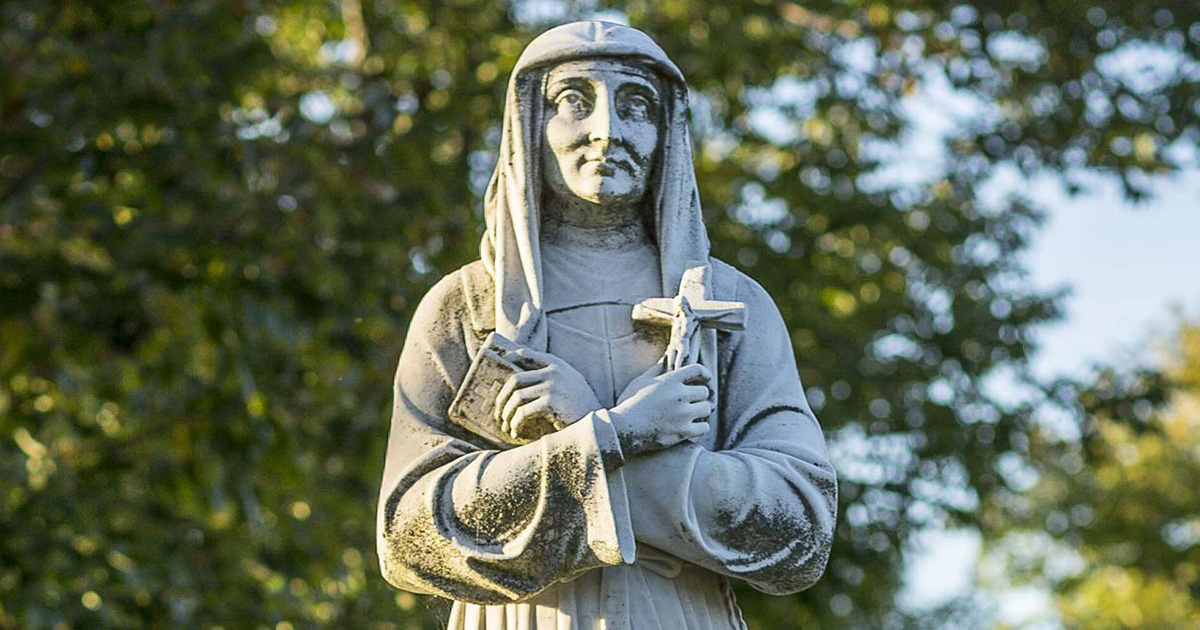Out of the Darkness with Louise de Marillac and Elizabeth Ann Seton
Meditating on the trials and struggles of St. Louise de Marillac and Mother Seton gives us hope in these uncertain times. We learn that holiness is found not in flashes of glory, but in the messy spaces where one watches, prays, and waits.
In his canonization homily for St. Elizabeth Ann Seton, St. Paul VI praised our first American-born saint for her “complete femininity.” Elizabeth, he said, was a model “of what women can and must accomplish, in the fulfillment of their role, for the good of humanity.” He placed her in the august company of other woman saints who lived the vocations of wife, mother, widow, and foundress—including Louise de Marillac, the woman who co-founded the Daughters of Charity, the order that inspired Elizabeth’s congregation of women religious, the Sisters of Charity of St. Joseph’s.
Reading Paul VI’s words, a picture begins to emerge of this “complete” woman, who has done all things well, imbuing every stage of her life with her feminine grace. And, I must admit, in this moment, I am having a hard time relating.
I’m a full-time mother of three children who are attending school via Zoom in the tiny space that is my home, where I also write full-time. In these days of COVID-19, my regular juggling act has morphed into a comedy routine—with balls coming down daily around me. I am less and less capable, more and more frantic. And when I do finally find my equilibrium, all it takes is one glance at the news for me to lose it once again in a swirl of panic.
What I long for right now is a sense of how to go forward in this situation. So, when it comes to the saints, I want to know: did they suffer these things, too? Did they fail? Did they feel unworthy and useless, desperate and alone? Did they know their need? And, if so, what happened next?
It turns out that Elizabeth Ann Seton and Louise de Marillac are two women who have much to share in these areas. Although they lived two centuries apart (Louise died in 1660, Elizabeth in 1821), one senses that when Elizabeth and Louise met in heaven, they experienced an immediate sympatico, an “I-get-you-sister” kind of sisterhood.
Both women lived through lonesome childhoods fraught with difficulty. Both married men who made ruinous financial decisions, suffered long illness, and died prematurely. Both persevered in the protracted process of founding a religious community. And, even more striking, both Louise and Elizabeth suffered from a period of “darkness” that modern biographers often label “depression.” And this is a good place to start.
Louise’s darkness came during her marriage, but it was in some ways the result of her difficult upbringing. Her father was a nobleman, but her mother was unknown—a lover that he had between one wife and the next. Louise suffered mightily from the lack of her mother’s presence and the consequent scorn of her father’s relatives. Trying to make up for it, her father had her educated among Dominican nuns, but after he died, the relatives sent Louise to live with a spinster in a boarding house, where she slaved for her daily bread.
When Louise was of age, her relatives secured a match for her with a decent husband, Antoine le Gras, secretary to the household of the queen. Louise and Antoine married and had a son, Michele, a difficult child who was a constant worry to his mother. And then, in the space of a few years, Antoine lost his job, imprudently invested their family funds, and fell ill. As Louise cared for him, fear began to overtake her heart.
Louise had earlier felt a call to religious life. Were all her sufferings punishment for her decision to wed Antoine? Was God displeased with her? For years, she suffered under a feeling of darkness and judgment. Gradually, all sense of her faith slipped away, until her beliefs—in heaven, eternity, God himself—crumbled, and she lived ten days of excruciating darkness.
Then, something happened. Sitting in church one day, Louise received an interior illumination, a flash of understanding, that she knew with certainty came from God. In this “lumiere,” as she called it, this moment of light, she knew that she must remain faithful to her husband until his death, when she would join other women in a consecration to the service of the poor. In the same flash, she knew who her spiritual director would be — St. Vincent de Paul (the man with whom she would one day found the Daughters of Charity).
Buoyed by this moment of supernatural certainty, Louise went forward toward everything the vision promised. It was a turning point and a sheer grace, but it came only after a long struggle. Speaking about the ten days of spiritual anguish that preceded the moment of light, one of Louise’s biographers says that she “spoke to no one, but clung blindly to God by prayer, crying out to Him incessantly like one shipwrecked on raging waters..
Elizabeth Ann Seton gives a similar witness in the midst of her darkest moment. It came when she was already a foundress of a small group of Sisters in the Maryland wilderness.
Elizabeth’s three daughters had trustingly followed her to the cold, damp woods, but Anna Maria, the eldest, became sick. When it was clear that she was stricken with deadly tuberculosis, her mother barely left her side. Then Anna Maria died, and Elizabeth almost lost her mind. She was tortured by the thought that her Anna was not in heaven, and that they would never met again. Overcome with feelings of anguish, she turned to prayer, as she herself relates, “begging, crying to Mary to behold her Son and plead for us, and to Jesus to behold His Mother—to pity a mother, a poor, poor mother so uncertain of reunion.”
She clung to Jesus and Mary for months. And the darkness gradually began to fade.
In Elizabeth’s and Louise’s experience, there is much for us to ponder. In dark moments, Elizabeth is “begging” and “pleading.” Louise is “clinging” to God, “crying out incessantly.” In their moments of anguish, these women stretch out their hands like poor beggars searching for scraps of consolation.
Is this not “complete femininity”—not just prettified piety, but true human need, simply and honestly expressed? Can we not all see ourselves in Louise’s darkness, in Elizabeth’s unraveling? And can we hear the wisdom of their response?
Life is long. Salvation is wrought in the day-to-day. We don’t have to do everything well. We just have to cling and beg for His mercy.
I love this answer that comes through Elizabeth and Louise. It makes my mess bearable. It gives me hope in these uncertain times. Truly, holiness is found not in flashes of glory, but in the cluttered spaces where one watches, and prays, and waits.
LISA LICKONA, STL, is Assistant Professor of Systematic Theology at Saint Bernard’s School of Theology and Ministry in Rochester, New York, and a nationally-known speaker and writer. She is the mother of eight children.
Image: Statue of St. Louise de Marillac (1591-1660) on the grounds of the National Shrine of Saint Elizabeth Ann Seton.
This reflection was originally published in 2020.
Source: https://setonshrine.org/
Tags:








Thank you!
Thank you. I came across your article accidentally; well perhaps not! The examples of these Saints have helped me in my struggle with anxiety, and with the unique needs of my own eight children. I feel graced by this story.